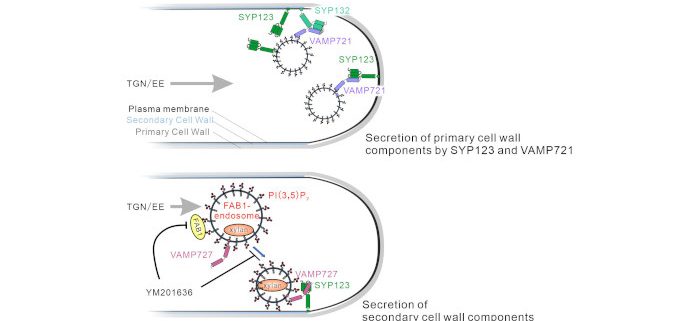How do root hairs keep their tubular shape?
Hirano et al. uncover the secretion route for root hair shank hardening in Arabidopsis. The Plant Cell (2023).
https://doi.org/10.1093/plcell/koad240
By T. Hirano, K. Ebine, T. Ueda, T. Higaki, T. W.-Nakayama, H. Konno, H. T.-Imamura, and M. H. Sato
Background: Root hairs are rapidly growing tubular projections of root epidermal cells and play an essential role in plant water and nutrient uptake. Root hair formation involves tip growth and the concomitant hardening of the shank by producing a secondary cell wall layer to form an elongated tubular structure.
Question: The polarized secretion of materials in the root hair tip has been well studied. However, little is known about the secretion of secondary cell wall materials in the root hair shank.
Findings: We observed increased localization of SYP123 at the plasma membrane of the subapical and shank zones compared to the tip region in elongating root hairs. Inhibition of PtdIns(3,5)P2 production impaired SYP123 localization in the plasma membrane and SYP123-mediated root hair shank hardening, and root hair elongation in syp123 mutant is insensitive to the PtdIns(3,5)P2 synthesis inhibitor. SYP123 interacts with both VAMP721 and VAMP727. The syp123 and vamp727 mutants exhibited reduced shank cell wall stiffness due to impaired secondary cell wall components deposition. In conclusion, the SYP123/VAMP727-dependent secretion system delivers secondary cell wall components for hardening the subapical zone and shank of Arabidopsis root hairs.
Next steps: Further studies are needed to confirm the detailed molecular mechanisms underlying the multiple secretion pathways for root hair morphogenesis.
Reference:
Tomoko Hirano, Kazuo Ebine, Takashi Ueda, Takumi Higaki, Takahiro Watanabe-Nakayama, Hiroki Konno, Hisako Takigawa-Imamura, and Masa H. Sato. The SYP123-VAMP727 SNARE complex is involved in the delivery of secondary cell wall components for hardening the root hair shank in Arabidopsis https://doi.org/10.1093/plcell/koad240




